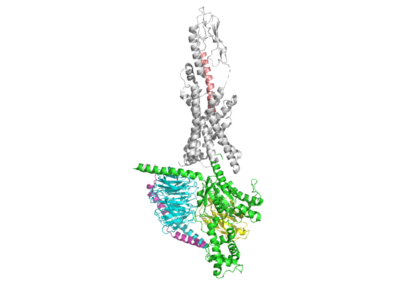User:Preston Roa/Sandbox 1
From Proteopedia
(Difference between revisions)
| Line 31: | Line 31: | ||
One way in which the Tirzepatide peptide fosters biased signaling is by utilizing particular residues from both GLP-1 and GIP in order to carefully stimulate parts of both pathways. | One way in which the Tirzepatide peptide fosters biased signaling is by utilizing particular residues from both GLP-1 and GIP in order to carefully stimulate parts of both pathways. | ||
| - | [[Image:Tirzepatide modifications.jpg]]Figure 1. The tirzepatide ligand can be viewed as a combination of both GLP-1 and GIP natural hormones. Shown in red are all the modified residues of tirzepatide. The blue residues are residues that both Tirzepatide and GLP-1 share. | + | [[Image:Tirzepatide modifications.jpg]]Figure 1. The tirzepatide ligand can be viewed as a combination of both GLP-1 and GIP natural hormones. Shown in red are all the modified residues of tirzepatide. The blue residues are residues that both Tirzepatide and GLP-1 share. |
One way in which the Tirzepatide peptide differs from both GLP-1 and GIP is seen through two mutations at residue sites 2 and 13. These residues have been mutated to mutant AIB residue which is physiologically vital for the performance of the drug as it prevents cleavage from the enzyme DPP-4, which normally cleaves the native GLP-1 peptide <scene name='10/1037513/7rgp-_2aib_mutation/4'>Tirzepatide 2AIB Mutation</scene> <scene name='10/1037513/7rgp_-_13aib_mutation/4'>Tirzepatide 13AIB Mutation</scene>. Tirzepatide binds similarly to the native GLP-1 peptide to its GLP-1R by forming hydrogen bonds with the receptor. Y1 of the Tirzepatide peptide is seen hydrogen bonding with Q234 of the GLP-1R, allowing for the peptide to be anchored to the receptor <scene name='10/1037513/Y1_hbond_w_q234/8'>Tirz Hbond Y1 Q234</scene>. The Tirzepatide drug is furthermore stabilized to the GLP-1R through pi-stacking interactions between Y10 of the drug and Y145 of the receptor <scene name='10/1037513/Pi_stacking_y10_and_y145/5'>Pi Stacking Y10 (Tirzepatide) and Y145 (GLP-1R)</scene>. | One way in which the Tirzepatide peptide differs from both GLP-1 and GIP is seen through two mutations at residue sites 2 and 13. These residues have been mutated to mutant AIB residue which is physiologically vital for the performance of the drug as it prevents cleavage from the enzyme DPP-4, which normally cleaves the native GLP-1 peptide <scene name='10/1037513/7rgp-_2aib_mutation/4'>Tirzepatide 2AIB Mutation</scene> <scene name='10/1037513/7rgp_-_13aib_mutation/4'>Tirzepatide 13AIB Mutation</scene>. Tirzepatide binds similarly to the native GLP-1 peptide to its GLP-1R by forming hydrogen bonds with the receptor. Y1 of the Tirzepatide peptide is seen hydrogen bonding with Q234 of the GLP-1R, allowing for the peptide to be anchored to the receptor <scene name='10/1037513/Y1_hbond_w_q234/8'>Tirz Hbond Y1 Q234</scene>. The Tirzepatide drug is furthermore stabilized to the GLP-1R through pi-stacking interactions between Y10 of the drug and Y145 of the receptor <scene name='10/1037513/Pi_stacking_y10_and_y145/5'>Pi Stacking Y10 (Tirzepatide) and Y145 (GLP-1R)</scene>. | ||
Revision as of 03:06, 30 April 2024
GLP-1
| |||||||||||
References
[1] Drucker DJ, Habener JF, Holst JJ. Discovery, characterization, and clinical development of the glucagon-like peptides. J Clin Invest. 2017 Dec 1;127(12):4217-4227. doi: 10.1172/JCI97233. Epub 2017 Dec 1. PMID: 29202475; PMCID: PMC5707151.
[2] Mayendraraj, A., Rosenkilde, M. M., & Gasbjerg, L. S. (2022). GLP-1 and GIP receptor signaling in beta cells - A review of receptor interactions and co-stimulation. Peptides, 151, 170749. https://doi.org/10.1016/j.peptides.2022.170749
[3] Seino, Y., Fukushima, M., & Yabe, D. (2010). GIP and GLP-1, the two incretin hormones: Similarities and differences. Journal of diabetes investigation, 1(1-2), 8–23. https://doi.org/10.1111/j.2040-1124.2010.00022.x
Student Contributors
- Preston Roa
- Jack Guckien
- Sam Reichenbach


